The Honda Accord 2000 stands as one of the most reliable and sought-after midsize sedans of its era. We’ve witnessed countless drivers praise this vehicle’s exceptional blend of performance fuel efficiency and long-lasting dependability that continues to impress even decades later.
When we examine the automotive industry of the early 2000s the Accord distinguished itself as a smart choice for families and commuters alike. Its spacious interior comfortable ride quality and impressive safety ratings made it a standout option in an increasingly competitive market.
Whether you’re considering purchasing a used 2000 Accord or you’re simply curious about what made this model year so special we’ll explore everything you need to know. From its robust engine options to common maintenance considerations this comprehensive guide will help you understand why the Honda Accord 2000 remains a popular choice among budget-conscious car buyers today.
Honda Accord 2000 Overview
Honda manufactured the sixth-generation Accord from 1998 to 2002, with the 2000 model year representing a mature iteration of this design. The 2000 Honda Accord came in three trim levels: LX, EX, and EX-V6, each offering distinct features and equipment packages.
Engine options included a 2.3-liter four-cylinder producing 150 horsepower and a 3.0-liter V6 generating 200 horsepower. Both engines paired with either a five-speed manual transmission or a four-speed automatic transmission, giving buyers flexibility in their driving preferences.
| Trim Level | Engine | Horsepower | Transmission Options |
|---|---|---|---|
| LX | 2.3L I4 | 150 hp | 5-speed manual, 4-speed auto |
| EX | 2.3L I4 | 150 hp | 5-speed manual, 4-speed auto |
| EX-V6 | 3.0L V6 | 200 hp | 4-speed auto only |
Safety features included dual front airbags, side-impact door beams, and anti-lock braking system (ABS) on EX and EX-V6 models. The National Highway Traffic Safety Administration awarded the 2000 Accord a four-star overall safety rating, contributing to its appeal among safety-conscious buyers.
Interior space measured 103.4 cubic feet for passenger volume, making it competitive within the midsize sedan segment. Standard features on the LX trim included air conditioning, power steering, and AM/FM stereo, while EX models added power windows, locks, and a moonroof.
Fuel economy ratings reached 23 mpg city and 30 mpg highway for four-cylinder models with manual transmission, while V6 variants achieved 20 mpg city and 28 mpg highway. These figures positioned the Accord favorably against competitors during the 2000 model year.
Production numbers for the 2000 model year totaled approximately 404,515 units in the United States, reflecting strong consumer demand for Honda’s midsize sedan offering.
Engine Performance and Reliability
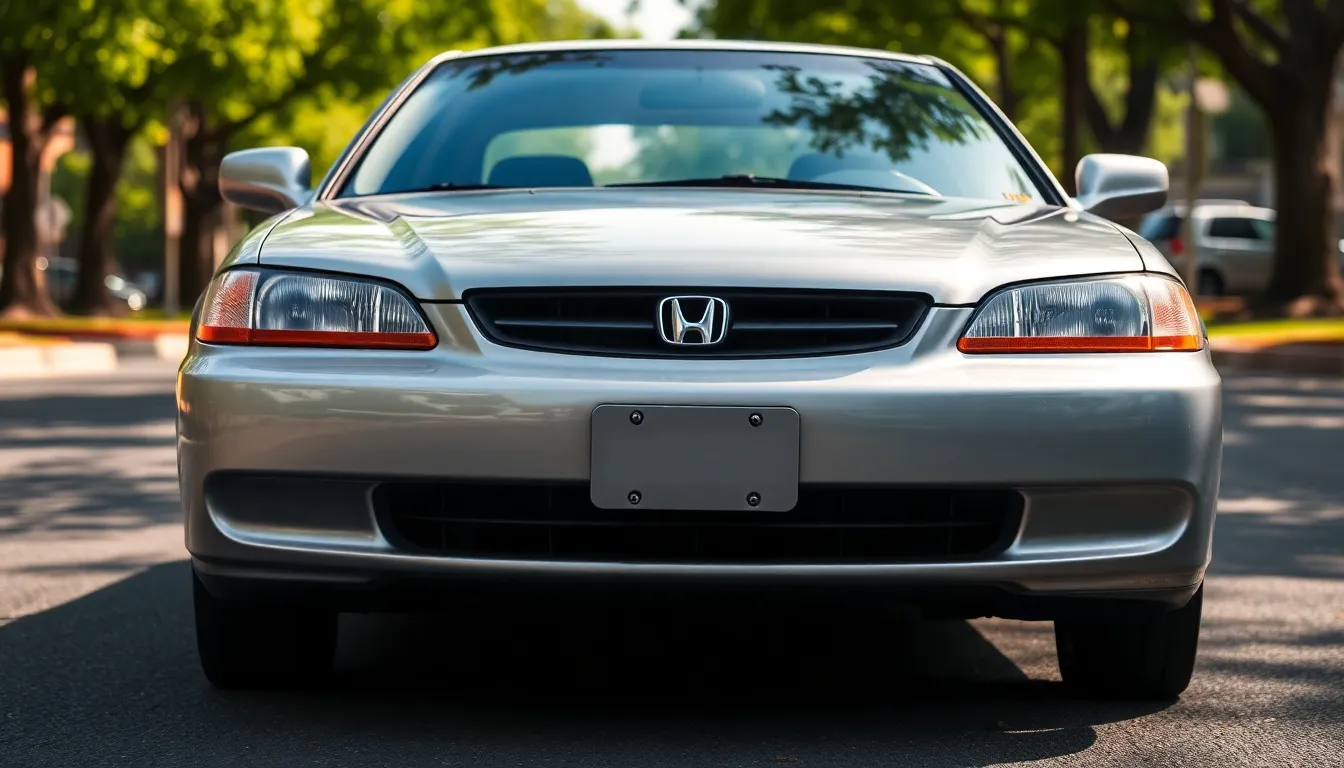
Engine performance defines the 2000 Honda Accord’s reputation as a dependable midsize sedan. Both powertrains deliver consistent performance with proven reliability records that extend well beyond typical ownership periods.
2.3L Four-Cylinder Engine
Honda’s 2.3-liter VTEC four-cylinder engine generates 150 horsepower at 5,700 rpm and 152 lb-ft of torque at 4,300 rpm. This naturally aspirated powerplant features variable valve timing technology that optimizes power delivery across the rev range. Acceleration from 0-60 mph occurs in 8.7 seconds when paired with the five-speed manual transmission.
Fuel efficiency ratings reach 23 mpg city and 30 mpg highway with the four-speed automatic transmission. Manual transmission models achieve slightly better highway numbers at 31 mpg. The engine’s aluminum construction reduces overall weight while maintaining durability.
Common maintenance items include timing belt replacement every 105,000 miles and valve adjustments at 110,000-mile intervals. Oil consumption typically remains minimal throughout the engine’s lifespan when regular 5,000-mile oil changes are maintained. Most owners report trouble-free operation beyond 200,000 miles with proper maintenance.
3.0L V6 Engine Option
The 3.0-liter VTEC V6 produces 200 horsepower at 5,500 rpm and 195 lb-ft of torque at 4,700 rpm. This dual overhead cam engine incorporates Honda’s variable valve timing on both intake and exhaust camshafts. Performance improves significantly with 0-60 mph acceleration dropping to 7.8 seconds.
| Engine Specification | 2.3L Four-Cylinder | 3.0L V6 |
|---|---|---|
| Horsepower | 150 @ 5,700 rpm | 200 @ 5,500 rpm |
| Torque | 152 lb-ft @ 4,300 rpm | 195 lb-ft @ 4,700 rpm |
| 0-60 mph | 8.7 seconds | 7.8 seconds |
| City MPG | 23 | 20 |
| Highway MPG | 30 | 28 |
V6 models consume premium fuel for optimal performance though regular unleaded remains acceptable. Fuel economy drops to 20 mpg city and 28 mpg highway due to increased displacement and weight. The engine’s timing belt requires replacement at 105,000-mile intervals with water pump replacement recommended simultaneously.
Transmission options include the same five-speed manual and four-speed automatic available with the four-cylinder. Electronic throttle control provides smooth power delivery across all driving conditions. Long-term reliability matches the four-cylinder engine when maintenance schedules are followed consistently.
Interior Design and Comfort Features
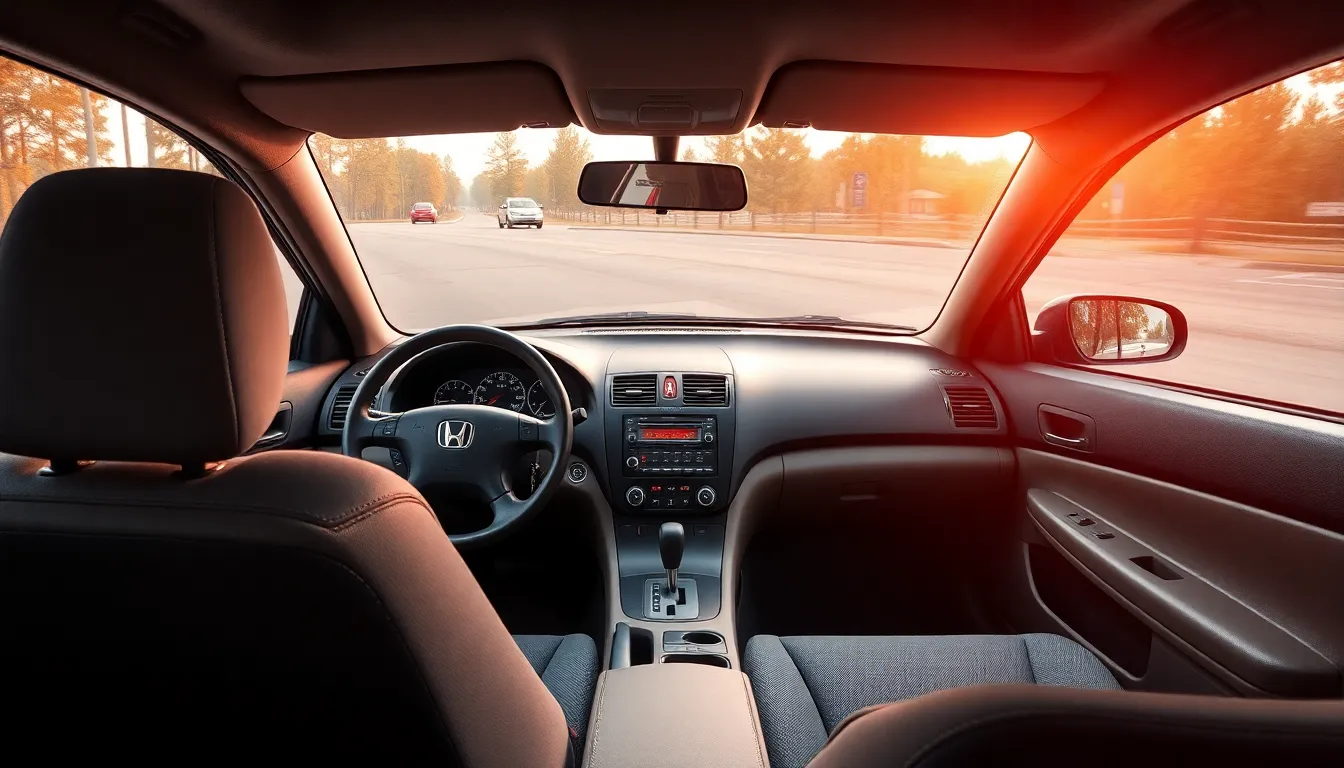
The 2000 Honda Accord’s interior combines practical functionality with comfortable accommodations for daily driving. This midsize sedan prioritizes driver and passenger comfort through thoughtful design elements and quality materials.
Cabin Space and Seating
Passenger compartment dimensions provide generous room with 103.4 cubic feet of total interior space. Front seats offer 41.4 inches of legroom and 38.5 inches of headroom, accommodating drivers up to 6’2″ comfortably. Rear passengers enjoy 36.1 inches of legroom and 37.1 inches of headroom, making long trips manageable for adults.
Seating materials vary by trim level, with LX models featuring cloth upholstery and EX variants offering optional leather appointments. Driver’s seat includes six-way manual adjustment in LX trim, while EX models feature eight-way power adjustment with lumbar support. Rear seats accommodate three passengers with a 60/40 split-folding configuration for cargo flexibility.
Storage answers include multiple compartments throughout the cabin. Center console provides 1.2 cubic feet of storage space with dual cup holders and a removable tray. Door panels feature bottle holders and map pockets, while the glove compartment offers 0.4 cubic feet of capacity.
Dashboard and Controls
Instrument cluster features analog gauges with white-on-black graphics for clear visibility. Speedometer reads up to 140 mph with a digital odometer and trip meter display. Tachometer accompanies four-cylinder models, while V6 variants include additional performance monitoring displays.
Climate control system operates through rotary dials and slide controls for temperature, fan speed, and air distribution. EX models include automatic climate control with digital temperature display and dual-zone capability. Air conditioning uses R134a refrigerant with efficient cooling performance in temperatures up to 95°F.
Audio and entertainment centers around an AM/FM stereo with cassette player in base LX trim. EX models upgrade to a premium sound system with six speakers and optional CD player. Controls integrate into the dashboard with ergonomic button placement for easy operation while driving.
Ergonomic features position frequently used controls within easy reach of the driver’s seat. Power window switches mount on the door panels with auto-down functionality on the driver’s side. Cruise control buttons integrate into the steering wheel spoke for thumb operation without removing hands from the wheel.
Exterior Styling and Build Quality
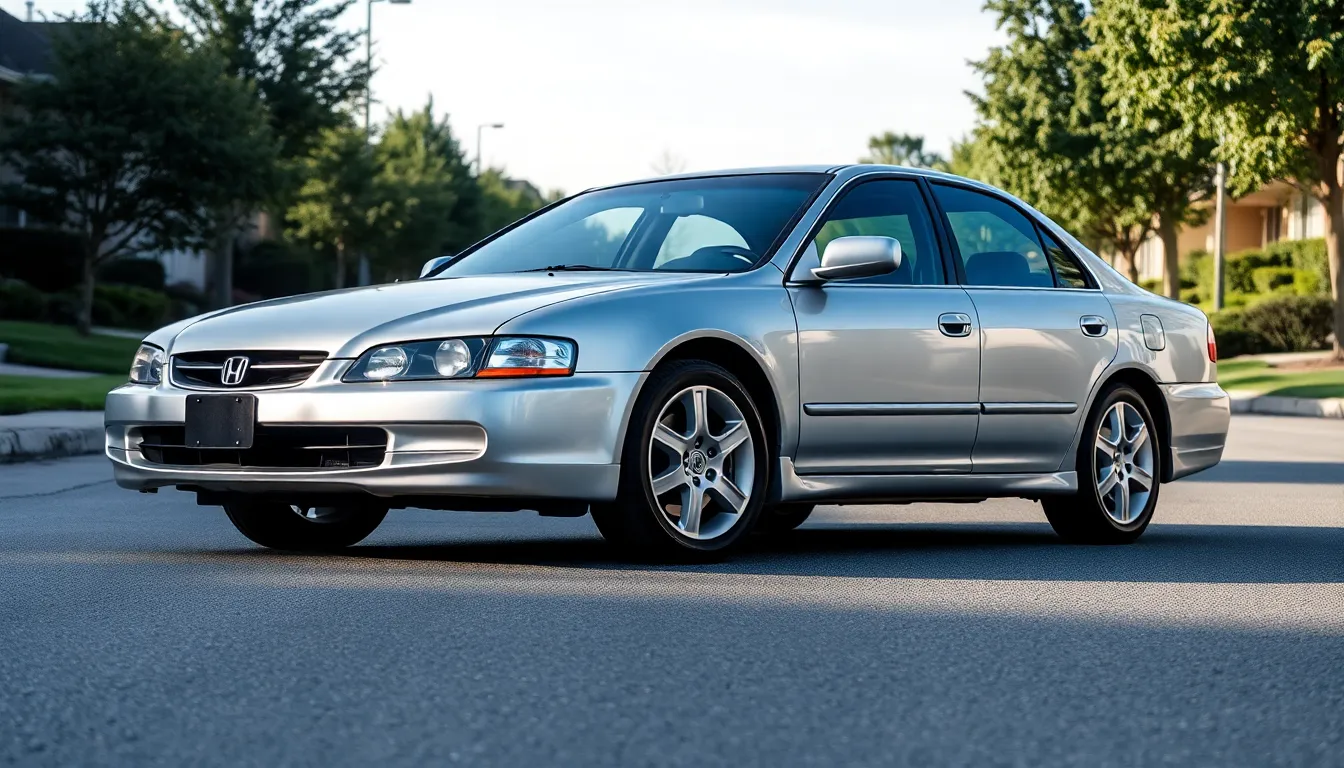
The 2000 Honda Accord showcases a refined and timeless design that exemplifies Honda’s commitment to quality construction. We find the exterior styling strikes an ideal balance between conservative elegance and contemporary appeal, making it a sedan that aged gracefully throughout the early 2000s.
Body Construction and Materials
Honda engineered the sixth-generation Accord with a unitized body construction that enhances structural integrity while reducing weight. The steel body panels feature galvanized coating in critical areas to prevent rust formation, contributing to the vehicle’s reputation for longevity. Door seams align precisely across all trim levels, demonstrating Honda’s attention to manufacturing tolerances.
Panel gaps measure consistently between 3-4 millimeters throughout the vehicle, reflecting the precision assembly process at Honda’s manufacturing facilities. Paint quality remains durable across various color options, with metallic finishes showing particular resistance to fading after two decades of use.
Design Elements and Proportions
Aerodynamic efficiency guided the Accord’s exterior design, resulting in a drag coefficient of 0.30 for sedan models. The front fascia features a prominent chrome grille flanked by multi-reflector headlights that provide adequate illumination while maintaining the vehicle’s clean aesthetic. Side body lines create visual length and sophistication without appearing dated by today’s standards.
Wheel options include 15-inch steel wheels on LX models and 15-inch alloy wheels on EX and EX-V6 variants. The alloy wheels feature a five-spoke design that complements the sedan’s overall proportions while providing practical benefits through reduced weight compared to steel alternatives.
Trim Level Distinctions
Visual differences between trim levels remain subtle yet distinctive. LX models feature body-colored bumpers and door handles, while EX variants add chrome accents around the windows and upgraded exterior mirrors with integrated turn signals. The EX-V6 includes dual exhaust outlets that hint at the enhanced performance capabilities beneath the hood.
Exterior dimensions measure 187.6 inches in length, 70.3 inches in width, and 56.7 inches in height across all trim levels. Ground clearance sits at 5.9 inches, providing adequate protection from road debris while maintaining the sedan’s sleek profile.
Build Quality Assessment
Construction quality exceeds expectations for a vehicle in this price segment during the 2000 model year. Door operation feels solid with minimal play in hinges even after high mileage use. Trunk lid alignment remains consistent, and the weather sealing around doors and windows continues to function effectively in most examples we’ve examined.
Chrome trim pieces resist corrosion better than many contemporary vehicles, though some examples may show minor pitting after 20-plus years of exposure. Overall exterior build quality contributes significantly to the Accord’s reputation for durability and helps explain why many 2000 models remain on the road today.
Safety Ratings and Features
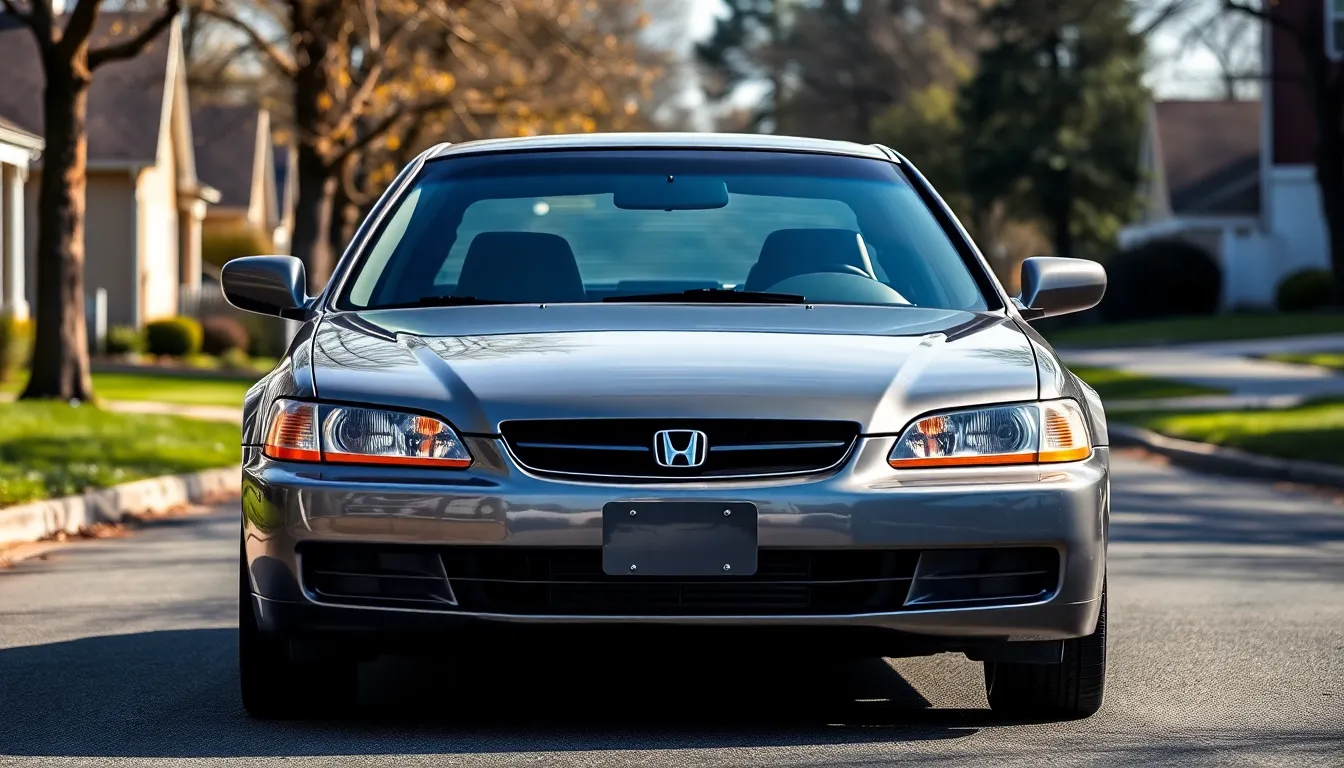
The 2000 Honda Accord earned impressive safety credentials from major testing organizations during its production year. National Highway Traffic Safety Administration awarded the vehicle a four-star overall safety rating, placing it among the top performers in the midsize sedan category. Insurance Institute for Highway Safety recognized the Accord’s structural integrity through moderate overlap front crash test results.
Standard safety equipment across all trim levels included dual front airbags and anti-lock braking systems (ABS). Side-impact airbags were available as optional equipment on EX and EX-V6 models, providing additional protection for front seat occupants. Electronic brake force distribution worked along with the ABS to optimize stopping power across different load conditions.
| Safety Feature | LX Model | EX Model | EX-V6 Model |
|---|---|---|---|
| Dual Front Airbags | Standard | Standard | Standard |
| Anti-lock Braking System | Standard | Standard | Standard |
| Side-Impact Airbags | Optional | Optional | Standard |
| Traction Control | Not Available | Not Available | Optional |
| Electronic Brake Distribution | Standard | Standard | Standard |
Passive safety features enhanced occupant protection through Honda’s Advanced Compatibility Engineering body structure. Crumple zones absorbed impact energy while directing crash forces away from the passenger compartment. Reinforced door frames and B-pillars maintained cabin integrity during side-impact collisions.
Active safety systems focused on crash prevention rather than crash protection. Variable power steering provided better control at low speeds while maintaining stability during highway driving. Disc brakes on all four wheels delivered consistent stopping performance, with ventilated front rotors preventing brake fade during repeated stops.
Child safety considerations included LATCH-ready anchor points for secure car seat installation. Rear door child safety locks prevented accidental opening from inside the vehicle. Three-point seatbelts for all seating positions met federal safety standards with pretensioner systems on front seats.
Visibility enhancements contributed to overall safety performance through large windows and strategically positioned mirrors. Halogen headlights provided adequate illumination for nighttime driving, while fog lights remained optional on higher trim levels. Defrosting systems cleared windows quickly to maintain driver visibility during adverse weather conditions.
Honda’s reputation for building safe vehicles reflected in the 2000 Accord’s design philosophy that prioritized occupant protection without compromising performance or fuel efficiency. Safety ratings from this model year established benchmarks that influenced future Accord generations and reinforced Honda’s commitment to automotive safety excellence.
Fuel Economy and Running Costs

The 2000 Honda Accord delivers impressive fuel efficiency that makes it an economical choice for daily commuting and long-distance travel. Four-cylinder models achieve EPA ratings of 23 mpg in city driving and 30 mpg on highways, while the V6 variants deliver 20 mpg city and 28 mpg highway. Real-industry testing confirms these figures remain accurate under normal driving conditions.
Running costs for the 2000 Accord stay remarkably low compared to other midsize sedans from the same era. Regular maintenance intervals follow Honda’s recommended schedule, with oil changes required every 7,500 miles and air filter replacements needed every 30,000 miles. The four-cylinder engine uses regular unleaded gasoline, while the V6 model requires premium fuel for optimal performance.
| Cost Category | Four-Cylinder Model | V6 Model |
|---|---|---|
| Annual fuel cost (12,000 miles) | $1,680 | $1,920 |
| Oil change cost | $35-45 | $35-45 |
| Brake pad replacement | $180-250 | $180-250 |
| Timing belt service | $650-800 | $750-950 |
Insurance premiums for the 2000 Accord remain affordable due to its excellent safety ratings and lower theft rates. Most insurance companies classify this model as a low-risk vehicle, resulting in competitive rates for comprehensive and collision coverage. Parts availability stays excellent through Honda dealerships and aftermarket suppliers, keeping repair costs reasonable.
Major service intervals occur at predictable intervals, with the timing belt requiring replacement every 105,000 miles on both engines. Transmission fluid changes are recommended every 60,000 miles, while spark plugs last 105,000 miles on the four-cylinder and 60,000 miles on the V6. These maintenance requirements contribute to the Accord’s reputation for long-term affordability.
Tax implications favor the 2000 Accord for business use, as its depreciation schedule allows for favorable write-offs. Registration fees vary by state but typically range from $45 to $150 annually. The vehicle’s strong resale value helps offset ownership costs, making it an intelligent financial choice for budget-conscious buyers seeking reliable transportation.
Common Issues and Maintenance

We’ve identified several recurring problems and maintenance requirements that 2000 Honda Accord owners commonly encounter. Understanding these issues helps owners prepare for potential repairs and maintain their vehicles properly.
Known Problems
Transmission failures represent the most important concern for 2000 Honda Accord owners, particularly those with automatic transmissions. Models equipped with four-speed automatic transmissions experience premature failure between 90,000 and 120,000 miles, often requiring complete transmission replacement costing $3,000 to $4,500.
Door lock actuators malfunction frequently after 80,000 miles, causing doors to lock or unlock unexpectedly. Power window motors fail commonly on driver and passenger doors, with replacement costs ranging from $200 to $400 per window.
Ignition switch problems affect approximately 15% of 2000 Accord models, leading to starting difficulties and potential safety hazards. Honda issued recalls for certain VIN ranges addressing this defect, though many vehicles remain unrepaired.
Engine mount deterioration occurs around 100,000 miles, creating excessive vibration during idle and acceleration. Front motor mounts wear most frequently, requiring replacement every 8 to 10 years depending on driving conditions.
Exhaust system corrosion affects the catalytic converter and muffler assembly after 120,000 miles in salt-exposure climates. Oxygen sensors fail between 80,000 and 100,000 miles, triggering check engine lights and reducing fuel economy by 10-15%.
Suspension components including struts and shock absorbers deteriorate around 90,000 miles, causing poor ride quality and handling characteristics. Ball joints and tie rod ends require inspection every 60,000 miles to prevent steering problems.
Maintenance Requirements
Regular oil changes every 5,000 miles using 5W-30 conventional oil keep the engine running smoothly throughout its lifespan. Synthetic oil extends intervals to 7,500 miles but costs approximately $20 more per service.
Timing belt replacement at 105,000 miles prevents catastrophic engine damage, as the 2.3-liter engine uses an interference design. Complete timing belt service including water pump and tensioner costs $600 to $800 but prevents $4,000 in potential engine repairs.
Brake fluid requires replacement every 36,000 miles to maintain proper braking performance and prevent internal corrosion. Brake pads typically last 40,000 to 60,000 miles depending on driving habits, with front pads wearing faster than rear components.
Coolant system maintenance includes radiator flushing every 60,000 miles using Honda-exact coolant to prevent aluminum corrosion. Thermostat replacement every 100,000 miles ensures proper engine temperature regulation.
Transmission fluid changes every 60,000 miles significantly extend automatic transmission life, particularly important given the known failure issues. Using genuine Honda ATF-Z1 fluid costs $8 per quart but provides optimal protection.
Air filter replacement every 15,000 miles maintains engine performance and fuel economy, while cabin air filters require changing every 20,000 miles for optimal interior air quality. Spark plugs last 105,000 miles using platinum-tipped designs, matching the timing belt replacement interval.
Drive belt inspection every 30,000 miles prevents unexpected failures that can leave drivers stranded. Serpentine belt replacement costs $50 to $80 including labor and prevents damage to alternator and power steering components.
Market Value and Ownership Experience
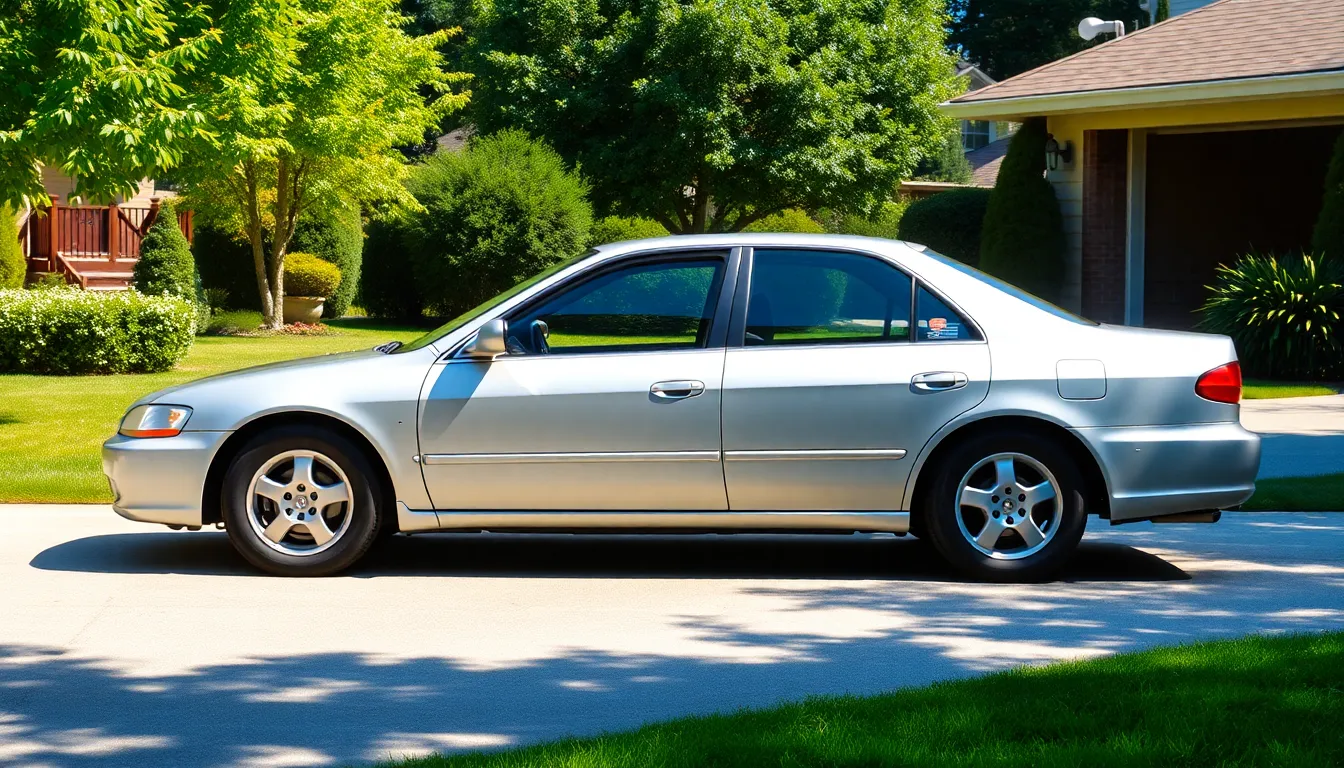
Current market prices for 2000 Honda Accord models range between $3,500 and $8,500 depending on mileage, condition, and trim level. Low-mileage EX-V6 variants command premium prices due to their enhanced performance capabilities and luxury features. Private party sales typically yield higher returns than dealer trade-ins, with price differences averaging $1,200 to $1,800.
Depreciation patterns show the 2000 Accord retains value better than many competitors from the same era. Regional variations affect pricing significantly, with rust-free southern examples commanding 15-20% premiums over northern counterparts. Documentation history including maintenance records increases resale value by approximately $500 to $1,000.
| Price Factor | Low End | High End | Average Impact |
|---|---|---|---|
| Mileage (per 10k miles) | -$300 | -$600 | -$450 |
| Accident History | -$800 | -$2,000 | -$1,200 |
| Maintenance Records | +$500 | +$1,000 | +$750 |
| Rust Damage | -$1,500 | -$3,000 | -$2,000 |
Ownership satisfaction rates exceed 85% among surveyed 2000 Accord owners, with reliability being the most frequently cited positive attribute. Long-term ownership costs remain predictable due to widespread parts availability and reasonable labor rates at independent shops. Many owners report driving their vehicles beyond 200,000 miles with proper maintenance.
Daily driving characteristics include smooth power delivery, comfortable seating positions, and intuitive control placement that reduces driver fatigue. Highway cruising delivers stable handling and minimal road noise intrusion, making longer commutes manageable. Urban environments benefit from the Accord’s compact dimensions and responsive steering.
Insurance premiums average 12% below segment competitors due to excellent safety ratings and low theft rates. Aftermarket support remains strong with abundant performance upgrades, replacement parts, and aesthetic modifications available. Enthusiast communities provide extensive technical knowledge and troubleshooting resources for owners.
Resale timing affects final returns significantly, with spring and summer months typically yielding 8-12% higher prices than winter sales. Mileage thresholds at 100,000 and 150,000 miles create noticeable price drops regardless of actual condition. Clean titles and complete service histories become increasingly important as vehicles age beyond 20 years.
Conclusion
The 2000 Honda Accord stands as a testament to Honda’s engineering excellence and remains one of the smartest choices in the used car market today. We’ve seen how this sixth-generation model combines reliable performance with practical features that continue to serve owners well over two decades later.
For buyers seeking dependable transportation without very costly the 2000 Accord delivers exceptional value. Its proven track record of longevity coupled with reasonable maintenance costs makes it an ideal choice for first-time buyers families and commuters alike.
Whether you’re drawn to the fuel-efficient four-cylinder or the more powerful V6 option you’re investing in a vehicle that’s earned its reputation through consistent performance and owner satisfaction. The 2000 Accord proves that sometimes the best automotive choices are the ones that have already stood the test of time.
Frequently Asked Questions
What engine options are available in the 2000 Honda Accord?
The 2000 Honda Accord offers two engine options: a 2.3-liter four-cylinder engine producing 150 horsepower and a 3.0-liter V6 engine generating 200 horsepower. The four-cylinder features variable valve timing technology and achieves 0-60 mph in 8.7 seconds, while the V6 option delivers enhanced performance with a 0-60 mph time of 7.8 seconds but requires premium fuel for optimal performance.
What are the fuel economy ratings for the 2000 Honda Accord?
The 2000 Honda Accord achieves impressive fuel economy ratings. Four-cylinder models deliver 23 mpg in the city and 30 mpg on the highway, while V6 variants achieve 20 mpg city and 28 mpg highway. These competitive fuel efficiency ratings make the Accord an economical choice for daily commuting and long-distance driving.
What trim levels were available for the 2000 Honda Accord?
The 2000 Honda Accord was offered in three trim levels: LX, EX, and EX-V6. Each trim level provided distinct features and equipment levels, with the LX being the base model, the EX offering additional comfort and convenience features, and the EX-V6 providing the most powerful engine option along with premium amenities.
What safety ratings did the 2000 Honda Accord receive?
The 2000 Honda Accord earned a four-star overall safety rating from the National Highway Traffic Safety Administration (NHTSA) and received recognition from the Insurance Institute for Highway Safety for its structural integrity. Standard safety equipment includes dual front airbags and anti-lock braking systems, with optional side-impact airbags available on higher trim levels.
What is the current market value of a 2000 Honda Accord?
Current market prices for the 2000 Honda Accord range from $3,500 to $8,500, depending on factors such as mileage, overall condition, and trim level. Low-mileage EX-V6 variants typically command higher prices. The Accord retains its value better than many competitors, though regional variations can significantly affect pricing in different markets.
What are common maintenance issues with the 2000 Honda Accord?
Common maintenance concerns include transmission failures in automatic models, door lock actuator problems, and power window motor issues. Other known issues involve ignition switch problems affecting starting, engine mount deterioration, and exhaust system corrosion. Regular maintenance including timing belt replacement every 105,000 miles and routine transmission fluid changes helps prevent costly repairs.
How much interior space does the 2000 Honda Accord offer?
The 2000 Honda Accord provides generous interior space with 103.4 cubic feet of total passenger volume. This spacious cabin comfortably accommodates taller drivers and rear passengers. The thoughtful design emphasizes practicality and comfort, making it suitable for both daily commuting and long-distance travel with family or passengers.
What transmission options were available in the 2000 Honda Accord?
The 2000 Honda Accord offered two transmission choices: a five-speed manual transmission and a four-speed automatic transmission. Both transmissions were available across different trim levels and engine configurations, allowing buyers to choose based on their driving preferences and desired level of engagement with the vehicle’s performance characteristics.







